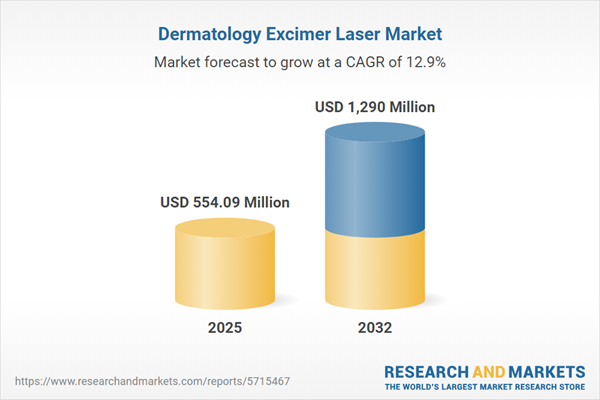Speak directly to the analyst to clarify any post sales queries you may have.
The dermatology excimer laser market is experiencing significant evolution, supported by advanced therapeutic applications and a dynamic competitive environment. Senior decision-makers now face an ecosystem shaped by technological innovation, regulatory shifts, and sophisticated partnership strategies.
Market Snapshot: Dermatology Excimer Laser Market Outlook
The dermatology excimer laser market grew from USD 491.13 million in 2024 to USD 554.09 million in 2025. It is projected to continue expanding at a CAGR of 12.91%, reaching USD 1.29 billion by 2032.
This growth reflects the rising demand for precise dermatological interventions, increasing adoption in both established and emerging markets, and the sector’s responsiveness to clinical need.Scope & Segmentation
This report provides comprehensive segmentation and regional breakdowns, delivering clarity for strategic planning and investment:
- Product Types: Fixed spot systems, scanning platforms
- Technology Variants: 172 nm, 222 nm, 308 nm wavelength excimer lasers
- Distribution Channels: Offline channels via medical equipment dealers; online procurement platforms
- End Users: Ambulatory surgery centers, dermatology clinics, hospitals, research institutes
- Clinical Applications: Alopecia areata, atopic dermatitis, psoriasis, vitiligo
- Target Regions: Americas (including North America and Latin America), Europe, Middle East and Africa, Asia-Pacific; with covered sub-countries across all geographies
- Key Players: Coverage includes Strata Skin Sciences, Lutronic, El.En., Asclepion Laser Technologies, Cutera, Lumenis, Syneron Medical, Alma Lasers, Sciton, and Merz Pharma, among others
Key Takeaways for Decision-Makers
- Excimer lasers have transitioned from experimental technology to mainstream dermatological therapy, empowering clinicians with precision and control while minimizing systemic side effects.
- Strategic partnerships between device manufacturers and digital health innovators are advancing real-time therapy management and expanding remote monitoring capabilities for patient-centric care.
- Growing adoption of combination treatment protocols, integrating excimer laser therapy with topical or systemic agents, is driving clinical efficacy and practitioner acceptance.
- Emerging technology variants and modular system designs are enabling tailored approaches for diverse skin conditions and varying patient needs.
- Regional emphasis on local certifications, service networks, and domestic production is shaping go-to-market strategies and enhancing brand confidence among providers.
Tariff Impact: Navigating 2025 U.S. Import Tariffs
The imposition of new U.S. import tariffs in 2025 has prompted excimer laser manufacturers to reexamine supply chains, expand domestic sourcing, and consider localized assembly to offset increased duties. These shifts are resulting in stronger alliances with U.S. distribution partners and a focus on maintaining affordability for end users across clinical settings. Contract structures and pricing models have adapted flexibly in response to incremental cost pressures, ensuring continuity of access for healthcare operators.
Methodology & Data Sources
This report integrates primary interviews with clinicians, hospital managers, and industry executives to capture market realities and expectations. Secondary data was compiled from peer-reviewed journals, regulatory documentation, open financial filings, and intellectual property records, ensuring triangulation and consistency. Rigorous cross-validation procedures and scenario modeling were used to minimize bias and highlight key industry risks and trends.
Why This Report Matters
- Offers actionable strategic insights and frameworks to support long-term planning in the rapidly evolving excimer laser market.
- Unpacks the effects of regulatory and economic changes, including tariffs, on procurement, supply chain, and competitive positioning.
- Highlights regional growth pockets and the relevance of emerging technological innovations for commercial strategy alignment.
Conclusion
The dermatology excimer laser market is defined by clinical innovation, adaptive business models, and a focus on robust partnerships. Stakeholders who invest in digital integration and evidence-based research are well-positioned to capture new opportunities in this dynamic sector.
Additional Product Information:
- Purchase of this report includes 1 year online access with quarterly updates.
- This report can be updated on request. Please contact our Customer Experience team using the Ask a Question widget on our website.
Table of Contents
3. Executive Summary
4. Market Overview
7. Cumulative Impact of Artificial Intelligence 2025
Companies Mentioned
The companies profiled in this Dermatology Excimer Laser market report include:- Strata Skin Sciences, Inc.
- Lutronic Co., Ltd.
- El.En. S.p.A
- Asclepion Laser Technologies GmbH
- Cutera, Inc.
- Lumenis Ltd.
- Syneron Medical Ltd.
- Alma Lasers Ltd.
- Sciton, Inc.
- Merz Pharma GmbH & Co. KGaA
Table Information
| Report Attribute | Details |
|---|---|
| No. of Pages | 193 |
| Published | October 2025 |
| Forecast Period | 2025 - 2032 |
| Estimated Market Value ( USD | $ 554.09 Million |
| Forecasted Market Value ( USD | $ 1290 Million |
| Compound Annual Growth Rate | 12.9% |
| Regions Covered | Global |
| No. of Companies Mentioned | 11 |









